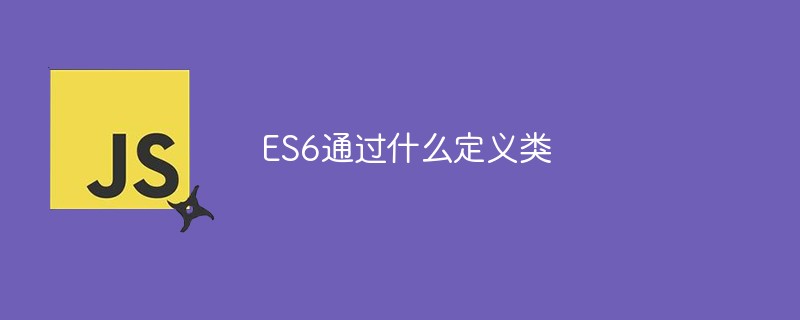ES6通过什么定义类
- 青灯夜游原创
- 2022-03-09 18:52:281617浏览
在ES6中,class(类)作为对象的模板被引入,可以通过“class”关键字来定义类。class的本质是function,它可以看作一个语法糖,让对象原型的写法更加清晰、更像面向对象编程的语法。

本教程操作环境:windows7系统、ECMAScript 6版、Dell G3电脑。
ES6 Class
在ES6中,class(类)作为对象的模板被引入,可以通过“class”关键字来定义类。
class 的本质是 function。
基本上,ES6的class可以看作只是一个语法糖,它的绝大部分功能,ES5都可以做到,新的class写法只是让对象原型的写法更加清晰、更像面向对象编程的语法而已。
基础用法
类定义
类表达式可以为匿名或命名。
// 匿名类
let Example = class {
constructor(a) {
this.a = a;
}
}
// 命名类
let Example = class Example {
constructor(a) {
this.a = a;
}
}类声明
class Example {
constructor(a) {
this.a = a;
}
}注意要点:不可重复声明。
class Example{}
class Example{}
// Uncaught SyntaxError: Identifier 'Example' has already been
// declared
let Example1 = class{}
class Example{}
// Uncaught SyntaxError: Identifier 'Example' has already been
// declared注意要点:
类定义不会被提升,这意味着,必须在访问前对类进行定义,否则就会报错。
类中方法不需要 function 关键字。
方法间不能加分号。
new Example();
class Example {}类的主体
属性
prototype
ES6 中,prototype 仍旧存在,虽然可以直接自类中定义方法,但是其实方法还是定义在 prototype 上的。 覆盖方法 / 初始化时添加方法
Example.prototype={
//methods
}添加方法
Object.assign(Example.prototype,{
//methods
})静态属性
静态属性:class 本身的属性,即直接定义在类内部的属性( Class.propname ),不需要实例化。 ES6 中规定,Class 内部只有静态方法,没有静态属性。
class Example {
// 新提案
static a = 2;
}
// 目前可行写法
Example.b = 2;公共属性
class Example{}
Example.prototype.a = 2;实例属性
实例属性:定义在实例对象( this )上的属性。
class Example {
a = 2;
constructor () {
console.log(this.a);
}
}name 属性
返回跟在 class 后的类名(存在时)。
let Example=class Exam {
constructor(a) {
this.a = a;
}
}
console.log(Example.name); // Exam
let Example=class {
constructor(a) {
this.a = a;
}
}
console.log(Example.name); // Example方法
constructor 方法
constructor 方法是类的默认方法,创建类的实例化对象时被调用。
class Example{
constructor(){
console.log('我是constructor');
}
}
new Example(); // 我是constructor返回对象
class Test {
constructor(){
// 默认返回实例对象 this
}
}
console.log(new Test() instanceof Test); // true
class Example {
constructor(){
// 指定返回对象
return new Test();
}
}
console.log(new Example() instanceof Example); // false静态方法
class Example{
static sum(a, b) {
console.log(a+b);
}
}
Example.sum(1, 2); // 3原型方法
class Example {
sum(a, b) {
console.log(a + b);
}
}
let exam = new Example();
exam.sum(1, 2); // 3实例方法
class Example {
constructor() {
this.sum = (a, b) => {
console.log(a + b);
}
}
}类的实例化
new
class 的实例化必须通过 new 关键字。
class Example {}
let exam1 = Example();
// Class constructor Example cannot be invoked without 'new'实例化对象
共享原型对象
class Example {
constructor(a, b) {
this.a = a;
this.b = b;
console.log('Example');
}
sum() {
return this.a + this.b;
}
}
let exam1 = new Example(2, 1);
let exam2 = new Example(3, 1);
// __proto__ 已废弃,不建议使用
// console.log(exam1.__proto__ == exam2.__proto__);
console.log(Object.getPrototypeOf(exam1) === Object.getPrototypeOf(exam2));// true
Object.getPrototypeOf(exam1).sub = function() {
return this.a - this.b;
}
console.log(exam1.sub()); // 1
console.log(exam2.sub()); // 2【相关推荐:javascript视频教程、web前端】
以上是ES6通过什么定义类的详细内容。更多信息请关注PHP中文网其他相关文章!

